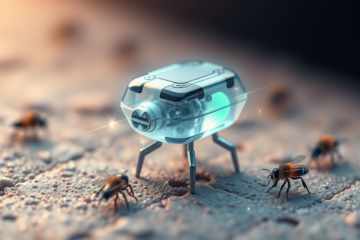SRT-H Robot Performs Autonomous Cholecystectomy
Autonomous Surgery has proven to be a promising innovation in the field of medicine, especially with the advent of the SRT-H Robot, which performs procedures such as cholecystectomy in a completely autonomous manner.
This article will explore the capabilities of this robot, its real-time interaction with medical staff through voice commands, and the training it received using videos of real surgeries.
Additionally, we will discuss their accuracy in simulated procedures and how their performance compares to that of experienced surgeons.
Finally, we will address expectations for future applications in living patients and the expansion of their surgical functions.
SRT-H Robot and the Revolution in Autonomous Surgery
Advances in autonomous surgery
is exemplified by SRT-H robot, who recently performed a cholecystectomy without direct human intervention, a remarkable feat.
This milestone underscores a new era in medical automation, where machines are capable of performing delicate procedures with exceptional precision.
O SRT-H robot is capable of interacting with the medical team through voice commands, allowing real-time adjustments during surgery.
This demonstrates a level of artificial intelligence that goes beyond the execution of pre-programmed orders, adapting actively respond to unexpected situations that may arise in medical procedures.
In addition to your skill autonomous, the SRT-H was extensively trained with videos of real surgeries, which ensures performance comparable to that of experienced surgeons in terms of clinical results.
However, even presenting an execution slower than that of a human, its accuracy and automatic correction capacity make it a valuable resource in the surgical environment.
It is expected that in the next decade, the SRT-H robot will expand its surgical capabilities and enable the automation of complex procedures with security, revolutionizing the future of medicine.
Real-time adaptation and interaction through voice commands
The SRT-H Robot represents a milestone in medical innovation by performing autonomous procedures with precision.
He understand in real time the nuances of the surgical environment, analyzing various sensory parameters captured during the intervention.
Dynamic adaptation is a crucial capability, allowing the robot to adjust its actions according to changes in the operating context.
This capability is made possible by the agile processing of collected data and the ability to make autonomous decisions.
Interaction through voice commands is another essential aspect that allows the SRT-H to function in a integrated into the medical team.
Commands are processed almost instantly, allowing real-time adjustments during surgery.
Through advanced natural language processing algorithms, the robot decodes verbal instructions, becoming an active participant in the surgical team.
Examples of commands include:
- “Grab the head of the gallbladder”
- “Adjust the position of the left arm”
- “Make the incision carefully”
This fluid interaction is similar to communicating with a resident, where the staff guides and responds to the machine, creating a synergistic workflow, Robotic Revolution shows more details about this.
Robot Performance and Accuracy
The performance and accuracy of the SRT-H robot in performing surgeries have shown promising results compared to human surgeons.
Although its speed is slower than that of an experienced surgeon, the robot achieved similar levels of effectiveness in clinical results.
The robot's ability to understand and adapt in real time, interacting with the medical team through voice commands, represents a significant advance in the automation of surgical procedures.
Training and accuracy in simulated procedures
O SRT-H Robot stands out for its ability to learn through videos of real surgeries, a method that transformed your performance in simulations.
During training, the robot analyzed and processed extensive hours of procedural videos, enriched with subtitles detailing each step.
This allowed the machine to not only understand surgical techniques, but also improve the precision of your actions in controlled simulations.
With each movement catalogued, the SRT-H absorbed subtle knowledge that orbits the field of real surgery, from the delicate manipulation of instruments to the exact moment to perform a precise incision.
Through this training, he demonstrated impressive capabilities in practical simulations, where the robotic precision was equal to that of experienced surgeons.
These skills were continually refined as the robot adapted to the subtleties of each procedure.
Furthermore, the simulation provided a safe environment for the robot to test its abilities, allowing for continuous refinement and ensuring that its performance in test scenarios was nothing short of exemplary.
Such advances position the SRT-H as a revolutionary tool in medicine, promising a future where complex procedures can be performed with greater confidence and accuracy than ever before.
Performance comparison with experienced surgeons
The surgical robot SRT-H emerges as a promising technological innovation in the field of medicine, providing an interesting point of comparison with experienced human surgeons.
Unlike the dexterity and speed of veteran surgeons, the SRT-H operates at a slower pace, highlighting its accuracy over speed.
However, its ability to perform complex procedures has been proven in several simulations, as highlighted in a publication by CNN Brazil.
Despite the longer operations, the SRT-H achieved equivalent clinical results to those of human surgeons, as observed on several occasions, mentioned in the clinical analyses available in RealTime1.
Precision and safety of the SRT-H, trained with videos of real surgeries, represent an essential evolution, even when speed is compromised.
For many operations, the ability to adapt and interact in real time with medical teams is vital, demonstrating the effectiveness of the autonomous system.
In short, while human surgeons continue to outpace speed, the SRT-H robot demonstrates that safety and precision can be achieved autonomously, opening new horizons for future surgical procedures.
Prospects for live patient testing and expanding capabilities
The SRT-H Robot, which has already demonstrated the ability to perform cholecystectomy surgeries autonomously in controlled environments, is preparing to advance in the coming years with tests on living patients.
This significant milestone will seek to validate the robot's effectiveness and safety under real clinical operating conditions.
The expectation of using SRT-H in human patients represents a leap forward for medical robotics.
With potential for revolutionize surgical care, SRT-H may emerge as a solution for areas with a shortage of medical specialists.
The expansion of the robot's surgical capabilities aims not only to perform multiple types of surgeries, but also to autonomous management of complex procedures.
Medical teams already envision a future in which robots achieve impeccable precision, minimizing human error and post-operative complications.
The SRT-H is designed to adapt in real time, interacting with healthcare professionals through voice commands, which represents an invaluable advance in terms of efficiency and safety.
In the medium term, there is a clear intention to deepen the applications of SRT-H in amplified surgical processes.
This ongoing development promises to fully integrate the robot into a wide range of global medical scenarios.
Details about future applications can be followed from reliable sources like article in the newspaper Andradas Hoje which discusses robotic autonomy.
In short, Autonomous Surgery represents a significant advancement in medicine, with the SRT-H Robot leading the way.
The expectation is that, over time, its capabilities will expand, promoting a new era of safe and effective surgical procedures.



0 Comments